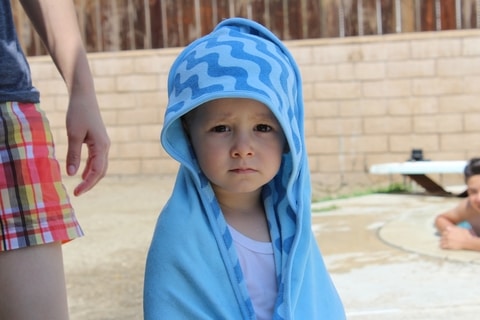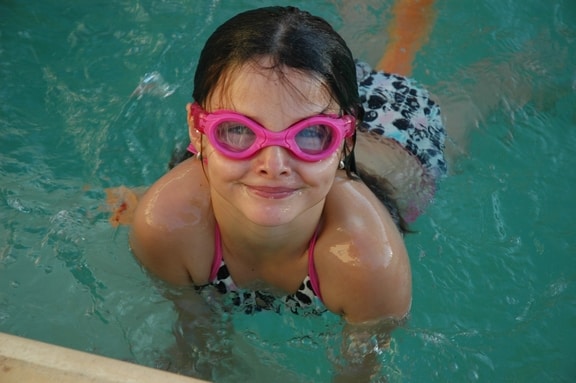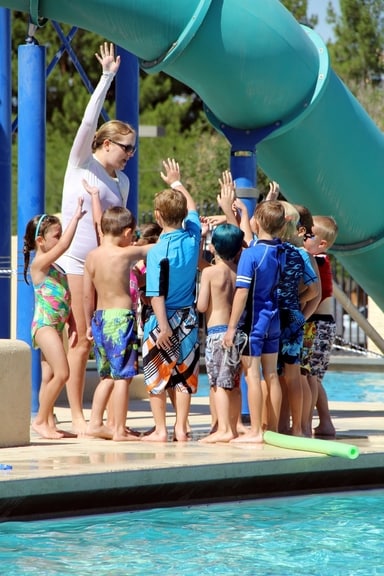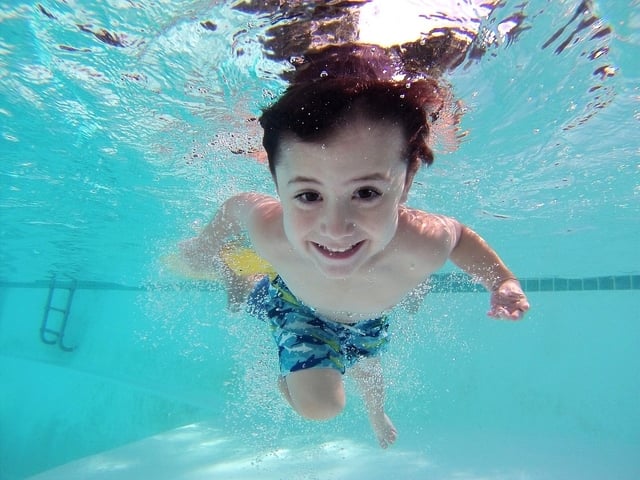Swimming for kids: To some extent, water is our native element, and that’s why swimming is so popular among both adults and children.
If you’re looking for a non-traumatic sport for your child that will strengthen their health and harden their body and character, then swimming for children is your optimum choice.
In this article, For Kids will give you all the information you need to know about swimming for kids. We’ll provide you with answers to the following questions:
- How much do swimming lessons cost?
- What is the right age to start teaching your kids to swim?
- What are the benefits of swimming and the drawbacks?
- What are the medical contraindications?
- What’s the best way to choose the swimming trainer and club?
Swimming for kids
Table of Contents
- 1. Best age
- 2. Benefits
- 3. Disadvantages
- 4. Cost
- 5. Boys and Girls
- 6. Medical contraindication
- 7. Choose academy
- 8. Summary
What is the best age to start swimming lessons for kids?
When talking about the optimal age to start swimming lessons for kids, it’s necessary to differentiate between two types of training:
- Sending a child to the swimming pool to learn swimming just for fun
- Sending a child to swim as part of a sports program
In the first case, this can be done in infancy, under the strict supervision of an instructor. Even at five months of age, a baby can get started with some movements like floating on their back.
Of course, the infant won’t yet learn how to swim, but it’ll become clear whether they like water, and if they don’t like it at first, whether they’ll be able to get used to it or not.
Some assume that this early experience of swimming may reduce the risk of drowning among toddlers, but this isn’t true, according to the American Academy of Pediatrics (AAP).
From two to three years of age, the child can gradually be taught to swim, but always in a playful way.
Experienced coaches insist that swimming shouldn’t be taken too seriously until a child reaches the age of five. Instead, let the child splash and play with water as they like.
That way, the swimming pool won’t turn into a punishment for the baby or child, and they’ll likely come to truly love the water.
Professional swimming lessons for children optimally begin at five to seven years of age. At this age, the child will become more coordinated. They’ll also be able to concentrate well, which will allow them to understand what the coach wants from them.
At this time, children will begin to learn to swim consciously, and even if they already know how to float, they’ll need to add the right technique and style to their strokes.
Benefits of swimming for kids
Swimming is useful for physical and mental health, as it’s considered not only a sport but also a type of leisure and a therapeutic method.
Let’s take a closer look at the advantages of swimming for kids.
1. Strengthening immunity
Swimming is one of the most effective forms of increasing the child’s immunity.
With regular exercises in the swimming pool, the mechanisms of thermoregulation will be improved, and the body will learn to adapt quickly to the changes in the external environment.
You can then forget about the seasonal colds of a child who swims, as they should be mild.
2. Stress relief
Swimming in water always brings up positive emotions. If your child is restless, very active or even aggressive, swimming will allow them to release excess energy and will provide a natural calming effect.
3. Physical development
Practically all muscle groups are involved in swimming, including the arms, legs and back. Such a uniform load helps a child form a harmonious and proportional figure, as well as improving their posture and increasing their endurance.
4. Disease prevention
Swimming lessons help prevent the curvature of the spine, the development of flatfoot and the occurrence of excess weight in a child.
5. Benefits for the body’s systems
Swimming improves the respiratory, cardiovascular, circulatory and nervous systems, which in turn strengthens the health of a small athlete in a comprehensive manner.
6. Character formation
Swimming training for kids with an instructor in the swimming pool involves discipline.
When they’re engaged in swimming professionally, a child will learn to be attentive, responsible and hardworking. They’ll develop the ability to understand the tasks assigned to them, and learn to accept both losing and winning.
Disadvantages of swimming for kids
Although swimming is one of the most suitable sports for kids, it still comes with a few drawbacks.
1. Frequent common colds
Despite the fact that regular training in water strengthens the immune system, many young athletes still often catch a cold.

To avoid this, the child must take a warm shower and do some warm-up exercises before their training sessions.
Additionally, carefully wash and dry your child’s hair after training, or if they’re old enough, have them do it themselves. Warm clothes, a scarf and a hat are obligatory in winter weather.
2. Asthma exacerbation
Since classes are always (or almost always) take place in a closed swimming pool, this means that several times a week, a child will breathe very humid air, most often accompanied by the smell of bleach.
If the child is prone to asthma or allergies, such conditions may increase this predisposition.
You can compensate for this by transferring at least some of the workouts—for example, during the warmer seasons—to natural water in the open air.
3. Chlorine effects
Finally, regular exposure to chlorine negatively affects the condition of the skin, nails and hair.
This can be avoided in two ways:
- Choosing a swimming pool with a different type of water purification than normal, such as a salt water pools
- Taking precautions such as showering after each lesson, getting proper nutrition, using a high-quality bathing cap, using children’s skin-nourishing cream, walking in the fresh air and so on
The average cost of swimming lessons and equipment

Compared to other sports, swimming doesn’t require large financial investments. The main items of expenditure are the swimming lessons with a trainer, plus two to three pieces of equipment.
Swimming lessons cost
Group training
The cost of one paid class with a trainer in a public group starts from $30 to $50 for a four-week session with one or two lessons per week, and ranges up to $392 for seven private lessons with a small group of students (the price is split between all participants) at the YMCA.
One-on-one private swimming lessons
The cost varies according to the academy, and whether you have a membership or not, but private lessons typically cost $40 to $330 per lesson.
For example, a 30-minute private lesson with Aqua Buddies, Spitzer Swimming or the YMCA costs around $40 for members.
Swimming equipment cost
The next item on your list will be equipment. You’ll need to buy:
- A one-piece swimsuit or swimming shorts for boys
- A cap
- Swimming goggles
- Shoes for the pool
- A towel
Everything, except for the swimming goggles, is best purchased in duplicates. The little athlete will also need a comfortable sports bag to keep everything in.
Away competitions cost
Finally, the last mandatory item is away competitions and fees.
The range of costs is very large because the costs will depend on the city or country you live in, the season, and the conditions of the club where your child is involved in swimming.
Differences between swimming for boys and girls
Swimming for children is a gender-neutral sport: the percentage of boys and girls is approximately equal. Therefore, gender isn’t a criterion for choosing this sport.
The only exception is synchronized swimming, as only girls can participate.
The character and personality of a child are more important than their gender since those factors will determine exactly what type of swimming is most suitable for a particular young athlete.
Here are some pointers to consult before choosing a specific type of swimming for your child:
- If your child loves communication, easily finds a common language with other children and feels more confident as part of a team, water polo will suit them.
- If you see leadership in your child, or they don’t like to share their achievements with anyone else, it’s better for them to start doing the individual swimming or water jumping sport.
- Is your daughter artistic, attentive and feeling good about her body? She’ll be perfect for a beautiful and spectacular synchronized swimming group.
Medical contraindications of swimming
Swimming is one of the safest and healthiest sports, but it still has a number of medical contraindications connected to it.
You can’t your child practice swimming if they have one of the following diseases:
- Skin diseases (dermatitis, eczema) and infections (scabies)
- Spinal injuries
- Congenital heart disease
- Other heart diseases
- Epilepsy
- Some disorders of the musculoskeletal system
The child must be healthy and have strong immunity to be fit to swim. So before sending your child to a swimming pool, be sure to consult your doctor.
Choice of swimming academy, instructor and lessons
The most important thing about teaching a child swimming is choosing a good swimming pool and an experienced coach. You should rely on the criteria outlined below when choosing a swim academy or a sports school.
Choosing a swimming academy
Regardless of whether your child will be engaged in synchronized or individual swimming, the pool must be clean.
Pay attention not only to the condition of the water, but also to the main source of fungi and other bacteria that may lie in the “contact” places, such as diving boards and ladders.
If these points of contact look dirty at all, it’s best to choose another pool.
Choosing a swimming instructor
Take a closer look at the coach’s work, including how they interact with children, what parents say about them, what kind of atmosphere prevails in the class and how well safety is controlled.
If little swimmers leave their workout in a good mood, this is a good sign.
You should also remember that the smaller the group, the more effective the classes are, and the children in it should be roughly the same age and at the same level of training.

Summary
Swimming for children is one of the healthiest and safest forms of physical activity.
Regular classes in the pool will provide a child with good health and a harmoniously developed body, and the water will give the child some emotional relaxation.
There are a variety of water disciplines that make up the sport of swimming, so you can choose the one that best suits your child, whether that child is an active extrovert or a purposeful individualist.
Regardless of whether you’re going to make your child a world champion in swimming, or you want them to be engaged just for fun, swimming will help them become hardened, resilient and brave.
References
- YMCA – Price of swimming classes
- Healthline – infant swimming – what are the benefits?
- Verywell Family – When to start swimming lessons for kids
- Griffith University – Research about the relationship between swimming and the cognitive and physical abilities of children
- Groupon – Cost of swimming lessons and schools


I like your advice to gradually teach children how to swim when they’re 2-3 years old and have more serious learning later on. It could help to find a baby swim class that offers a fun experience and still helps them gain some skill. This could help you trust your child to an experienced professional that can give them a chance to enjoy the water and stay safe while they have fun and get more confident while in the water.
Thanks for your reply